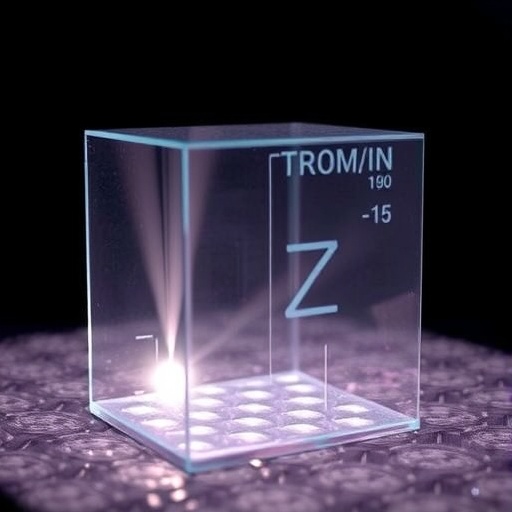In a groundbreaking study that could redefine the landscape of advanced materials, researchers have delved into the remarkable properties of ZnO/M nanocomposites, revealing their enhanced optical, dielectric, and ferromagnetic characteristics. The work, spearheaded by Mohamed et al., presents a detailed analysis that promises to pave the way for innovative applications in electronic devices, sensors, and beyond. This research is not just a mere examination of materials; it is a comprehensive undertaking that intersects multiple fields, combining principles from physics, materials science, and nanotechnology.
The study begins with a meticulous exploration of zinc oxide (ZnO), a material that has captivated scientists due to its versatile properties and potential in various applications. ZnO exhibits a wide bandgap, making it an excellent candidate for ultraviolet light-emitting devices, while its intrinsic piezoelectric properties open pathways for sensor technologies. However, the enhanced performance achieved through the integration with selected materials showcased in this research signifies a monumental step forward. The synthesis of ZnO/M nanocomposites marks a pivotal point in research and application.
One of the most intriguing aspects of this research is the method of nanocomposite fabrication. This approach enables the blending of different materials at the nanoscale, creating a composite that enhances the characteristics of the individual components. Specifically, the study highlights how the meticulous selection of “M” can induce desirable modifications in ZnO’s properties. This tailored method of synthesis not only results in compatibility of properties but also opens doors to novel functionalities that were previously unattainable with pure materials.
Optical properties serve as a focal point in this research, as the enhanced optical characteristics of the ZnO/M nanocomposites indicate potential for significant advancement in photonic applications. The research reports observable improvements in photoluminescence and transparency, which are critical for the development of next-generation optoelectronic devices. By fine-tuning the composition of ZnO/M nanocomposites, the research points towards the ability to develop materials that can efficiently harness and manipulate light, representing a leap towards more efficient solar cells and LEDs.
In addition to optical enhancements, the dielectric properties of the new nanocomposites have been investigated. The study reveals a remarkable increase in dielectric constant, which is essential for applications requiring significant energy storage. Increased dielectric properties can lead to advancements in capacitors and other electronic components, resulting in devices that are smaller, more efficient, and more powerful. This is particularly important in an age where miniaturization and efficiency are paramount to technological advancement.
Ferromagnetic properties in ZnO/M nanocomposites present another layer of intrigue. Traditional ZnO is a non-magnetic material, yet the research demonstrates that the inclusion of various magnetic elements can induce ferromagnetism. This finding holds great promise for applications in spintronic devices, where the spin of electrons is utilized for information processing. The emergence of magnetism in previously non-magnetic materials expands the possibilities for integrating magnetic functionalities into electronic circuits, thereby enhancing their operational capabilities.
Moreover, each aspect of the research interconnects to paint a broader picture of how these nanocomposites can be harnessed for advanced device applications. The versatility of the ZnO/M composites means they can be tailored to suit a wide range of applications, from high-speed electronic devices to innovative sensor technologies. The implications extend far beyond traditional electronics, potentially transforming industries such as telecommunications, renewable energy, and health monitoring.
The study illustrates a robust methodology combining both experimental and theoretical frameworks, revealing insights that are critical to understanding the underlying mechanisms that contribute to the enhanced properties observed. With its foundation relying on rigorous experimentation, complemented by advanced characterization techniques, this research embodies the collaborative spirit of scientific inquiry. The level of detail presented enhances the credibility of the findings and serves as a guide for future studies aimed at discovering new material combinations and functionalities.
Moreover, the collaboration among authors from diverse backgrounds reflects the interdisciplinary approach that modern scientific research demands. By leveraging expertise across various domains, the team has successfully illuminated pathways that could lead to pioneering breakthroughs in material science. This multi-faceted inquiry lays the groundwork for further investigations into alternative composite systems, driving the field towards even more innovative experimentation.
As the world increasingly hinges on advances in technology, the importance of research such as that conducted by Mohamed et al. becomes even more pronounced. The ability to engineer materials at the nanoscale not only equips scientists with the tools necessary to develop groundbreaking applications, but also aligns with global efforts towards sustainability. Improved materials can significantly enhance energy efficiency, aligning technological advancements with environmental responsibility.
In conclusion, Mohamed et al.’s research on ZnO/M nanocomposites transcends the boundaries of material science, weaving together threads from various disciplines to explore the interplay between material properties and application possibilities. It paints an optimistic picture for the future, revealing pathways through which these advanced materials can contribute to technological innovation. As we stand at the threshold of a new era in electronics and material science, the enhanced properties of ZnO/M nanocomposites may well be the key to unlocking future advancements.
With the foundation laid in this compelling study, the door is now open for researchers worldwide to build upon these findings. The implications of such advancements will undoubtedly resonate throughout the scientific community and industry, ushering in a new chapter in the use of nanocomposites in high-tech applications.
Subject of Research: Enhanced optical, dielectric, and ferromagnetic properties in ZnO/M nanocomposites.
Article Title: Enhanced optical, dielectric and ferromagnetic properties in ZnO/M nanocomposites for advanced device applications.
Article References:
Mohamed, M., Jaradat, E.K., Alshammari, A.S. et al. Enhanced optical, dielectric and ferromagnetic properties in ZnO/M nanocomposites for advanced device applications.
Sci Rep 15, 40353 (2025). https://doi.org/10.1038/s41598-025-26399-x
Image Credits: AI Generated
DOI: https://doi.org/10.1038/s41598-025-26399-x
Keywords: ZnO/M nanocomposites, optical properties, dielectric properties, ferromagnetic properties, material science, advanced device applications.




